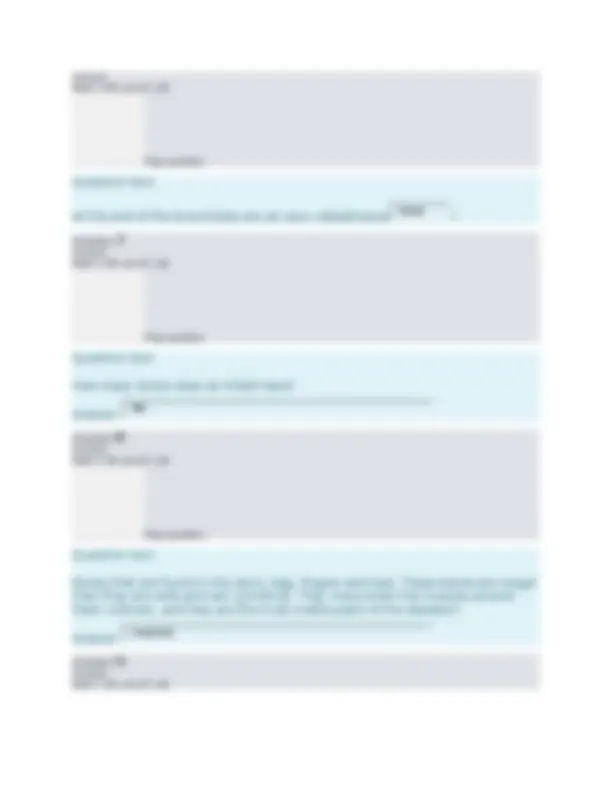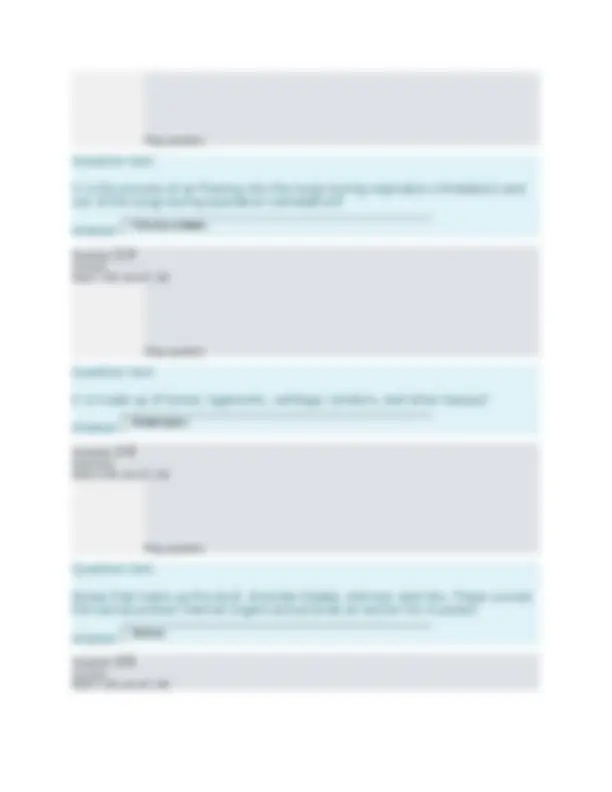





Study with the several resources on Docsity

Earn points by helping other students or get them with a premium plan


Prepare for your exams
Study with the several resources on Docsity

Earn points to download
Earn points by helping other students or get them with a premium plan
Community
Ask the community for help and clear up your study doubts
Discover the best universities in your country according to Docsity users
Free resources
Download our free guides on studying techniques, anxiety management strategies, and thesis advice from Docsity tutors
A quiz consisting of 20 questions related to anatomy and physiology. The questions cover topics such as bones, respiratory system, and gas exchange. The quiz is multiple choice and includes both correct and incorrect answers. The document could be useful as study notes or as a practice exam for students studying anatomy and physiology.
Typology: Exams
1 / 7

This page cannot be seen from the preview
Don't miss anything!




Correct Mark 1.00 out of 1. Flag question Question text Also known as breathing, involves both bringing air into the lungs (inhalation) and releasing air to the atmosphere (exhalation)? Answer:
Correct Mark 1.00 out of 1. Flag question Question text Bones that are found in the hands, wrists, feet, ears and knees. These small, round bones are embedded in tendons and protect them from the great pressure and force they encounter? Answer:
Correct External respiration Sesamoid bones
Question text The remaining 126 bones and it includes the arms, legs, shoulder girdle and pelvic girdle. The lower portion of the appendicular skeleton protects the major organs associated with digestion and reproduction and provides stability when a person is walking or running? Answer:
Correct Mark 1.00 out of 1. Flag question Question text It is the pressure of the air outside the body? Answer:
Correct Mark 1.00 out of 1. Flag question Question text It contains 80 bones, including the skull, spine and rib cage. It forms the central structure of the skeleton, with the function of protecting the brain, spinal cord, heart and lungs? Answer:
Appendicular skeleton Atmospheric pressure Axial skeleton
Question text It is the active phase of ventilation because it is the result of muscle contraction? Answer:
Correct Mark 1.00 out of 1. Flag question Question text Oxygen and carbon dioxide are exchanged between the cells and blood vessels? Answer:
Incorrect Mark 0.00 out of 1. Flag question Question text It is the pressure inside the alveoli of the lungs? Answer:
Correct Inspiration Internal respiration Intra-alveolar
Question text It is the process of air flowing into the lungs during inspiration (inhalation) and out of the lungs during expiration (exhalation)? Answer:
Correct Mark 1.00 out of 1. Flag question Question text It is made up of bones, ligaments, cartilage, tendons, and other tissues? Answer:
Incorrect Mark 0.00 out of 1. Flag question Question text Bones that make up the skull, shoulder blades, sternum and ribs. These curved, thin bones protect internal organs and provide an anchor for muscles? Answer:
Correct Pulmonary ventilation Skeletal system Flat bone
Question text It is the process of letting air out of the lungs during the breathing cycle? Answer:
Correct Mark 1.00 out of 1. Flag question Question text Bones that are in the spinal cord and face, which, because of their unique dimension, don't fit in any of the other shape categories? Answer:
Correct Mark 1.00 out of 1. Flag question Question text Bones that are found in the wrists and ankles and are about equal in their length, width and thickness? Answer: Expiration Irregular bones Short bones